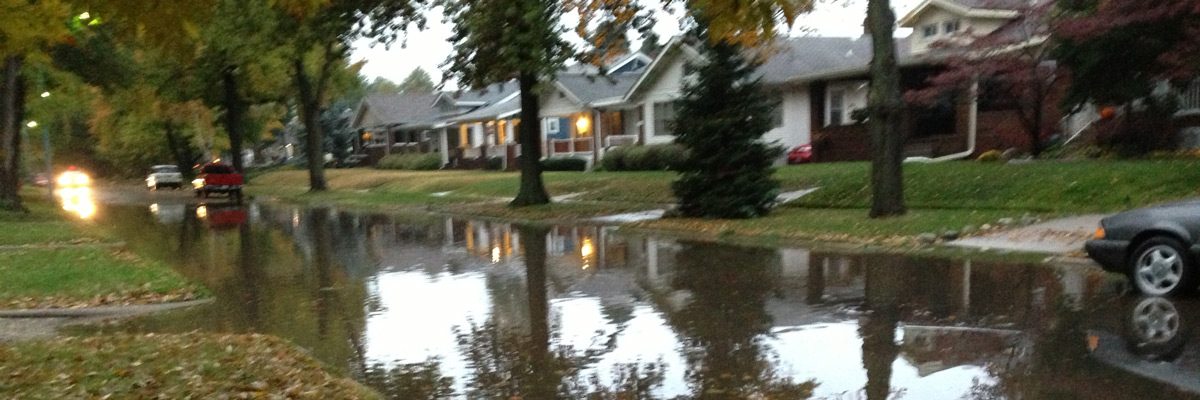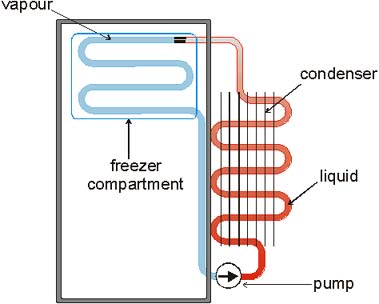If the Geothermal Heat Pump is the best, why not use it throughout the house? It’s true, you could use a Geothermal Heat Pump to refrigerate your food and heat your water. It’s expensive and against many of the principals CES stands for. Why? Well there is a number of reasons. One, you can’t use the same Geothermal Heat Pump to heat and cool your house and heat your water and cool your food. In fact you can’t even use the same Geothermal Heat Pump to heat your water and cool your food. A Geothermal Heat Pump works for conditioning your air in your house because it cycles through the heating and cooling system. That is it is reversible.
Heating water at the same time as cooling your food would require 2 additional Geothermal Heat Pumps and while that would save energy its a huge waste of equipment. At 2,000$ – 3000$ per Heat Pump you would be paying a lot for the privileged of hot water and cool food.
Second the best bet for heating water is either a tankless water heater or better yet a Solar Water Heater system. It is a toss up in Illinois which is better. The Tankless Water Heater is ideal for the cooling season because you get around the energy “war” between heating your water and cooling your house. Where Solar Water Heaters heat water efficiently they generally heat lots more water and need super insulation to avoid that energy “war”.
Using a 2000-3000$ device to cool your food? It would last virtually for ever so its life-cycle cost would be great. Still it seems somewhat futuristic. Most Refrigerators are build completely wrong anyway. The freezer should be at the bottom, the food compartment on top of that and the Compressor on top of that. After all cold falls and heat rises doesn’t it?
http://www.eere.energy.gov/consumer/your_home/water_heating/index.cfm/mytopic=12840
Heat Pump Water Heaters
Most homeowners who have heat pumps use them to heat and cool their homes. But a heat pump also can be used to heat water—either as stand-alone water heating system, or as combination water heating and space conditioning system.
How They Work
Heat pump water heaters use electricity to move heat from one place to another instead of generating heat directly. Therefore, they can be two to three times more energy efficient than conventional electric resistance water heaters. To move the heat, heat pumps work like a refrigerator in reverse.
While a refrigerator pulls heat from inside a box and dumps it into the surrounding room, a stand-alone air-source heat pump water heater pulls heat from the surrounding air and dumps it—at a higher temperature—into a tank to heat water. You can purchase a stand-alone heat pump water heating system as an integrated unit with a built-in water storage tank and back-up resistance heating elements. You can also retrofit a heat pump to work with an existing conventional storage water heater. They require installation in locations that remain in the 40º–90ºF (4.4º–32.2ºC) range year-round and provide at least 1,000 cubic feet (28.3 cubic meters) of air space around the water heater. Cool exhaust air can be exhausted to the room or outdoors. Install them in a space with excess heat, such as a furnace room. Heat pump water heaters will not operate efficiently in a cold space. They tend to cool the spaces they are in. You can also install an air-source heat pump system that combines heating, cooling, and water heating. These combination systems pull their heat indoors from the outdoor air in the winter and from the indoor air in the summer. Because they remove heat from the air, any type of air-source heat pump system works more efficiently in a warm climate.
Homeowners primarily install geothermal heat pumps—which draw heat from the ground during the winter and from the indoor air during the summer—for heating and cooling their homes. For water heating, you can add a desuperheater to a geothermal heat pump system. A desuperheater is a small, auxiliary heat exchanger that uses superheated gases from the heat pump’s compressor to heat water. This hot water then circulates through a pipe to the home’s storage water heater tank.
Desuperheaters are also available for demand (tankless or instantaneous) water heaters. In the summer, the desuperheater uses the excess heat that would otherwise be expelled to the ground. Therefore, when the geothermal heat pump runs frequently during the summer, it can heat all of your water. During the fall, winter, and spring—when the desuperheater isn’t producing as much excess heat—you’ll need to rely more on your storage or demand water heater to heat the water. Some manufacturers also offer triple-function geothermal heat pump systems, which provide heating, cooling, and hot water. They use a separate heat exchanger to meet all of a household’s hot water needs.
http://www.greenerbuilding.org/buying_advice.php?cid=104
Heat Pump Water Heater
Heat pump water heaters (HPWH) work using the same premise as any heat pump. Heat pumps transfer heat from one zone to another and most achieve efficiency factors (EF) of 2 to 3. Heat pumps gain their efficiency by using electricity to move heat versus using the electricity to create it.
Heat pumps move temperature from a warm location such as an outside space in a warm climate, near a furnace, or from the basement, to the water storage tank. The heat pump uses a heat exchanger located within the tank to transfer the warmth to the water. Because the HPWH extracts heat from the air it delivers about twice the heat as a conventional electric water heater.
The byproduct of this water heating is air cooling. In some applications the units can act as both a water heater and air conditioner. Depending on needs such as condition of current water heater, HPWHs are available as independent units, or as add-ons to existing systems. Initial purchase and maintenance can make these an expensive choice especially when inexpensive natural gas is an option. In appropriate applications, the HPWHs save energy in almost every situation.
The downside to greater efficiency is a more complicated installation. HPWHs should be installed by professionals who can assist with choosing a water heating system that matches your needs. The investment costs can be recouped quickly when hot water use and electricity costs are high. HPWHs are most efficient in warm climates or when installed in a heated location, such as a furnace room. Because the efficiency and capacity of the HPWH decrease as air temperatures drop, cold ambient temperature locations should be avoided.
Maintenance of HPWHs is higher than with other options, sometimes requiring routine heat exchanger coil cleaning as often as every 3 months. Heat pumps are slower than electric water heaters by about 25%. While this may not be an issue often, if the demand for hot water exceeds the supply the backup heaters come on, reducing efficiency of the entire unit.
:}
This is the one they like if you want to see a living breathing specimen:
http://www.aers.com/etech_residential_water_heating.html
:}
You probably have a heat pump in your home. Refrigerators ARE Heat Pumps. But they are never asked to heat any thing. In other words they are not dual cycle. The problem with refrigerators is that they ventilate in the house and during the cooling season this is simply a bad idea. Net cycle because they reduce the heating load during the heating season. A house with 3 heat pumps and a superinsulated water heater and a super insulated refrigerator such differences would be minute.
http://www.saburchill.com/physics/chapters/0126.html
Thermal Physics
If a heat engine is operated in reverse, as described above, it has the effect of transferring internal energy from a body at a low temperature to one at a higher temperature. It is then called a “heat pump” (or a refrigerator depending on what it is used for).
 |
A heat pump or fridge can be represented by a similar diagram to the one used for the heat engine but with the arrows representing energy flows reversed. |
An explanation of the operation of a fridge requires consideration of cooling caused by evaporation.
The temperature of a body is a measure of the average kinetic energy of its particles. During evaporation, the molecules which are more likely to “escape” from liquid and become part of the vapour are the ones which have higher than average kinetic energy. Therefore, if you cause the rate of evaporation of a liquid to increase, without supplying energy, the temperature of the remaining liquid will decrease.
The rate of evaporation of a liquid can be increased by
| i) | decreasing the pressure acting on its surface |
| ii) | blowing air over the surface (clothes dry more quickly on a windy day) |
| iii) | increasing the surface area of the liquid (evaporation only occurs at the surface) |
| iv) | increasing the temperature |
The diagram below shows the main parts of a refrigerator.
In the tubes around the freezer compartment, the pressure is decreased by the pump (there is a small section of the tube which is narrower than the rest). Rapid evaporation takes place here and latent heat of vaporisation is taken in.
In the tubes outside the refrigerator, the vapour is compressed and then it condenses. Latent heat is given out as it condenses.
:}
:}


Pingback: ground source heat pumps
Pingback: scrap gold phoenix
Pingback: Jessie
Pingback: Domestic Solar Power
Pretty insightful post. Never thought that it was this simple after all. I had spent a good deal of my time looking for someone to explain this subject clearly and you’re the only one that ever did that. Kudos to you! Keep it up
Vancouver Carpet Cleaning
Just foud this article. Actually you can use the geo for comfort control to preheat your hot water. This requires a buffer tank, but will heat the water to approx. 90 degrees. In the winter it will draw heat from the ground. In the summer it will use the heat extracted from the house. As to a refrigerator, yeah you’ll need a separate heat pump due to the reversing cycle between heating and cooling.
Pingback: how does solar panels work